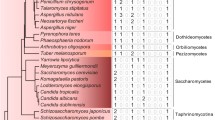Abstract.
Tubulin dimers of psychrophilic organisms can polymerize into microtubules at temperatures below 4°C, at which non-cold-adapted microtubules disassemble. This capacity requires specificities in the structure and/or in the posttranslational modifications of the tubulin subunits. A contribution to the knowledge of these specificities was provided by the finding that the amino acid sequence of the α-tubulin of the Antarctic ciliate Euplotes focardii contains substitutions that, in addition to conferring an increased hydrophobicity to the molecule, modify sites that are involved in α-/α-tubulin lateral contacts between protofilaments. At the level of the coding sequence, the α-tubulin gene of E. focardii revealed an A+T content appreciably higher than in its homologs in ciliates of temperate waters. This was interpreted as an adaptation to favor DNA strand separation in an environment which is energetically adverse.
Similar content being viewed by others
Author information
Authors and Affiliations
Additional information
Electronic Publication
Rights and permissions
About this article
Cite this article
Pucciarelli, S., Miceli, C. Characterization of the cold-adapted α-tubulin from the psychrophilic ciliate Euplotes focardii . Extremophiles 6, 385–389 (2002). https://doi.org/10.1007/s00792-002-0268-5
Received:
Accepted:
Issue Date:
DOI: https://doi.org/10.1007/s00792-002-0268-5




